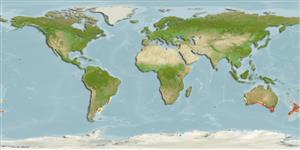Environment: milieu / climate zone / depth range / distribution range
Ecología
marino demersal; rango de profundidad 22 - 450 m (Ref. 58489), usually 100 - 250 m (Ref. 3243). Subtropical; 27°S - 48°S, 62°W - 176°W
Indo-Pacific: St. Paul and Amsterdam islands in the Indian Ocean, southern Australia, including Tasmania, and New Zealand. Southwest Atlantic: southern South America.
Length at first maturity / Tamaño / Peso / Age
Maturity: Lm 30.0, range 25 - 35 cm
Max length : 70.0 cm TL macho / no sexado; (Ref. 9563); common length : 35.0 cm TL macho / no sexado; (Ref. 3243); peso máximo publicado: 2.9 kg (Ref. 6390); edad máxima reportada: 50 años (Ref. 26998)
Short description
Claves de identificación | Morfología | Morfometría
Espinas dorsales (total) : 17 - 18; Radios blandos dorsales (total) : 25 - 28; Espinas anales: 3; Radios blandos anales: 14 - 15; Vértebra: 35. Adults have elongate upper pectoral-fin rays and are silvery with a broad black band from the nape to the pectoral-fin base (Ref. 33616).
Adults demersal on the continental shelf and upper slope (Ref. 9563) to depths of 450 m (Ref. 33616). Juveniles tend to live near shallow reefs (Ref. 6390). Postlarvae inhabit offshore waters and are found in surface waters at night (Ref. 9072). Average weight is 1800 g. Feed on polychaete worms, crustaceans, mollusks and echinoderms (Ref. 28626). Flesh is quite good eating. Often sold as tiki fillets.
Jackass morwong have an extended pelagic postlarval stage (Ref. 6390). Research in New Zealand has shown that metamorphosis to the juvenile stage occurs between 9 and 12 months after hatching (Ref. 28625).
Kailola, P.J., M.J. Williams, P.C. Stewart, R.E. Reichelt, A. McNee and C. Grieve, 1993. Australian fisheries resources. Bureau of Resource Sciences, Canberra, Australia. 422 p. (Ref. 6390)
IUCN Red List Status (Ref. 130435)
Threat to humans
Harmless
Human uses
Pesquerías: comercial; pesca deportiva: si
Herramientas
Special reports
Download XML
Fuentes de Internet
Estimates based on models
Preferred temperature (Ref.
123201): 11.1 - 16, mean 14 °C (based on 71 cells).
Phylogenetic diversity index (Ref.
82804): PD
50 = 0.5078 [Uniqueness, from 0.5 = low to 2.0 = high].
Bayesian length-weight: a=0.01288 (0.00970 - 0.01710), b=3.03 (2.95 - 3.11), in cm total length, based on LWR estimates for this species (Ref.
93245).
Nivel trófico (Ref.
69278): 3.4 ±0.42 se; based on food items.
Resiliencia (Ref.
120179): Bajo, población duplicada en un tiempo mínimo de 4.5-14 años (K=0.1-0.28; tm=3-6; Fec=100,000; tmax=50).
Prior r = 0.27, 95% CL = 0.18 - 0.40, Based on 2 full stock assessments.
Fishing Vulnerability (Ref.
59153): Moderate to high vulnerability (50 of 100).
Climate Vulnerability (Ref.
125649): Low to moderate vulnerability (26 of 100).
Nutrients (Ref.
124155): Calcium = 53.9 [34.9, 93.5] mg/100g; Iron = 0.942 [0.612, 1.486] mg/100g; Protein = 19.1 [17.3, 20.9] %; Omega3 = 0.381 [0.268, 0.531] g/100g; Selenium = 42.1 [24.0, 72.3] μg/100g; VitaminA = 9.17 [3.73, 21.69] μg/100g; Zinc = 0.658 [0.505, 0.900] mg/100g (wet weight);
